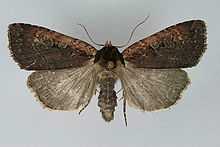Eugraphe sigma
From Wikipedia, the free encyclopedia
| Eugraphe sigma | |
|---|---|
 | |
| Scientific classification | |
| Kingdom: | Animalia |
| Phylum: | Arthropoda |
| Class: | Insecta |
| Order: | Lepidoptera |
| Family: | Noctuidae |
| Genus: | Eugraphe |
| Species: | E. sigma |
| Binomial name | |
| Eugraphe sigma (Schiffermüller, 1775) | |
| Synonyms | |
| |
Eugraphe sigma is a moth of the Noctuidae family. It is found from most of Europe (except Ireland, Great Britain, the Iberian Peninsula and Greece)[1] to the Ural, Siberia, Transcaucasia, Armenia and Korea.[2]
The length of the forewings is 17–20 mm. Adults are on wing from June to July in one generation per year.[3]
The larvae feed on various low-growing plants, including Lamium album, Viburnum lantana, Laburnum anagyroides, Prunus spinosa, Lonicera and Ligustrum species. Young larvae live in the top parts of the host plant. The species overwinters in the larval stage. After overwintering, the larvae hide during the day and feed on the terminal part of the twigs during the night. Pupation takes place in the ground.
Subspecies
- Eugraphe sigma sigma
- Eugraphe sigma melancholina Bryk, 1949 (Korea)
- Eugraphe sigma anthracina Boursin, 1954
References
This article is issued from Wikipedia. The text is available under the Creative Commons Attribution/Share Alike; additional terms may apply for the media files.